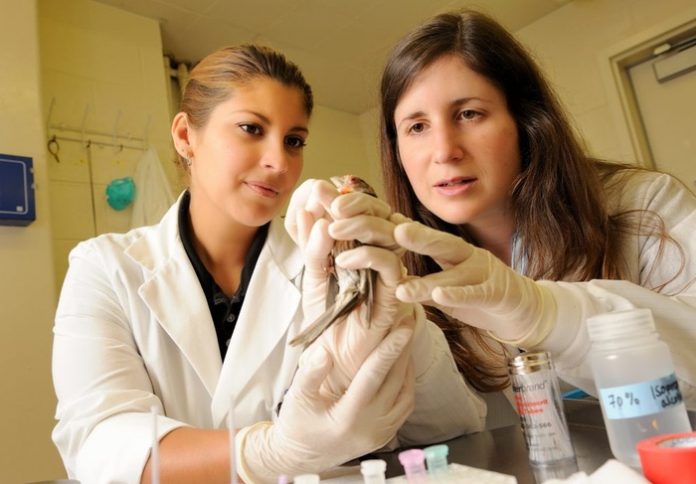Our differences are what make us unique. Different worldviews, different experiences, and even different hair colors can lead to a more diverse and interesting world.
But just as our many differences impact our societies, biological differences in how susceptible individuals are to a pathogen can also impact a global process: disease outbreaks.
Researchers at Virginia Tech and three other institutions — the University of Memphis, University of San Diego, and University of Connecticut — are studying this issue and how prior exposure to pathogens can affect the level of variation in a population.
Like a wall protecting a village from invaders, the variability of a population can protect against pathogen outbreaks and community transmission. Having an outer wall of vaccination only improves this protection.
What is not known is the level of variability that best protects a population, and if invaders had hopped the walls before, how much prior exposure in a population would make a difference in that variability.
Getting an idea of what this relationship looks like could allow researchers and decision-makers to better predict and prepare for potential outbreaks and variants.
“Understanding variation in susceptibility among individuals is really important for predicting the course of epidemics for humans, wildlife, and agricultural systems,” said Langwig, a co-investigator on the project and assistant professor from the Department of Biological Sciences in the College of Science.
The COVID-19 pandemic has emphasized this point. Uncertainty, misjudgment, and relentless change has made it especially difficult to predict the course of disease outbreaks. A warming climate exacerbates the problem, especially with mosquito-borne pathogens like West Nile virus and Zika.
The need for more comprehensive and explicit information is here, and that information comes from better models that consider variation in immunity.
“When we think about herd immunity, we think about a host as either immune or not, but that essentially assumes that it’s black or white,” Hawley said. “Immune systems have an incredibly variable response, so we know that hosts are along this huge spectrum from very low degrees of standing protection to full protection. Some of the models that we’ll be generating will be some of the first to really consider what happens when you have this variation.”
Repeated modeling and remodeling after experiments defines Hawley and her team’s study. The loop of testing and rebuilding models will lead to more precise and accurate results that can better predict how different variations will impact outbreaks and pathogen evolution.
“Our interdisciplinary work combining mathematical and computational tools with experimental and field research will advance our understanding of immune dynamics in the context of real-world variation,” said Childs, a co-investigator on the project and assistant professor from the Department of Mathematics in the College of Science.
The EEID grant gives Hawley, Langwig, Childs, and their team the opportunity to truly uncover what part variation and prior exposure plays in disease dynamics. So when another pandemic or disease outbreak does arise, we will be better prepared.
The four-year study comes as part of a $1.75 million grant funded by the National Institute of General Medical Sciences within a multi-agency program, the Ecology and Evolution of Infectious Diseases (EEID).
The project will involve Virginia Tech researchers Dana Hawley, Kate Langwig, and Lauren Childs, all affiliated faculty members of the Center for Emerging, Zoonotic, and Arthropod-borne Pathogens housed in the Fralin Life Sciences Institute. Hawley and Langwig are also affiliated faculty members of the Global Change Center.
“It’s not just about how well protected your population is,” said Hawley, principal investigator of the study and professor from the Department of Biological Sciences in the College of Science. “It also matters how much variability there is among individuals. You can have two populations that each have the same level of vaccination, but one population may have a lot more variability than another. We don’t really know how that affects both the degree to which an outbreak might occur and how the pathogen might be pressured to evolve.”
Every individual in a population is different in some way. These differences — age, genetics, acquired immunity, the coarseness of your nose hairs — make individuals either more or less susceptible to a pathogen infection. Prior exposure to a pathogen, the prime focus of the study, also can affect this susceptibility.
Collectively, the differences among individuals can lead to a certain level of variation among a population as a whole. Individuals in a population will not all have the same protection. This can have a vast effect on outbreaks and whether pathogens evolve into more virulent strains.
By studying house finch populations, Hawley and her team will test and model how different exposures to a common conjunctival pathogen will affect the variation in their populations. The research will not only apply to house finches but expand to human-pathogen relationships as well.
“The idea with this particular grant program is that you generate theory that is broadly relevant,” Hawley said. “Even though we’re using birds as a model, I think that the house finch-bacteria system really is a good model for any kind of human pathogen where you get these reinfection dynamics, which appears to be more and more the case for COVID-19.”








